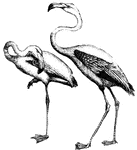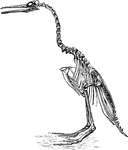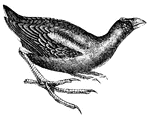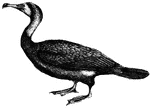Clipart tagged: ‘aquatic birds’

Albatross
The Albatross is the largest and most bulky of all the birds which fly over the surface of the sea.

Anhinga
The head of the anhinga is slender and cylindrical, on a slim and excessively long neck, which makes…

European Dipper
"Bill shorter that head, slender and compressed throughout, higher that broad at the nostrils, about…

Duck
The head and throat of the male duck can be emerald green with shots of violet. The female is brown…

Wood Duck
These birds have webbed-feet, with heavy, oily plumage. the body is flattened, and all are fine swimmers.

Flamingo
The flamingo is found in Africa and Asia. The color of the plumage is a deep brilliant scarlet, except…

Grebe
They pass swiftly through the air at the height of about a hundred yards, in flocks of from seven and…

Grebe
Diving birds, such as the grebe, have webbed (or lobed) feet and are expert in swimming and diving.

Guillemot
The guillemots have the beak long, straight, convex above, somewhat angular below. They only come ashore…

Heron
Herons are found on the edges of rivers, lakes and marshes and live on fishes, reptiles and sometimes…

Restoration of Hesperornis regalis
"Hesperornis regalis, (a fossilized restoration) which stood about three feet high, had blunt teeth…

The Restoration of the Hesperornis Regalis
"Hesperornis regalis, (a fossilized restoration) which stood about three feet high, had blunt teeth…

Jacana
These birds have long toes and claws that permit them to walk easily across leaves of tropical aquatic…

Loon
The loon is a diving bird that finds its food under the water. It will dip its bill into the water and…

Loon
The loon is a diving bird. Its peculiar cry, sometimes resembling a hysterical laugh, has given rise…

Petrel
Petrels never dive, and rarely swim. Instead they skim rapidly over the waves looking for food.

Petrel
Petrels resemble gulls, except in having the nostrils open as two parallel tubes on the top of the beak.

Screamer
Screamers live near moist marshy locations or sandy streams. They do not swim, but walk along the vegetation…

Screamer
Screamers live near moist marshy locations or sandy streams. They do not swim, but walk along the vegetation…

Skimmer
In skimmers the upper beak is shorter than the lower beak, allowing it to pick up shrimp and small fish…

Swan
The swan has been an object of admiration for its graceful neck, oval head, prominent beak, soft, and…

Black Swan
The swan has been an object of admiration for its graceful neck, oval head, prominent beak, soft, and…

Green-Winged Teal
This duck is beautifully colored and resembles a mallard. Its wings have an emerald green patch upon…

Tern
These birds are remarkable for their buoyant, graceful, easy flight, and the soft loose texture of their…

Royal Tern
"Sterna (T.) maxima. Cayenne Tern. Royal Tern. Adult in summer: Pileum glossy greenish-black, not extending…

























